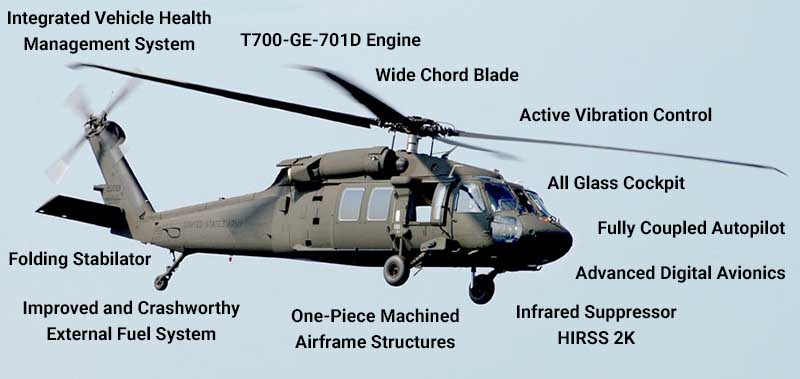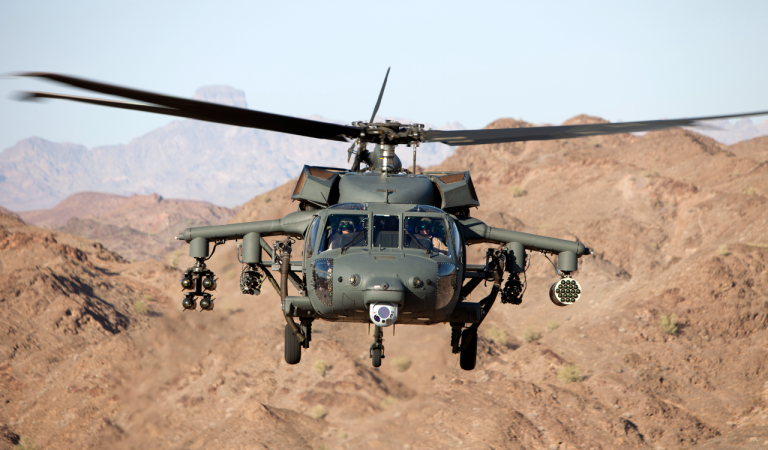Just how the UH 60 Changed Armed Force Aviation and Combat Procedures
Just how the UH 60 Changed Armed Force Aviation and Combat Procedures
Blog Article
UH-60: Developments in Modern Helicopter Style
The UH-60 helicopter stands as a benchmark in contemporary aeronautics, showcasing significant innovations in design and modern technology that cater to the progressing demands of armed forces procedures. As we explore the development and vital developments of the UH-60, it comes to be important to think about how these advancements affect not only present applications yet also the future landscape of helicopter layout.

Development of the UH-60
The evolution of the UH-60 Black Hawk helicopter represents a significant landmark in aerospace design and armed forces aviation. Introduced in the late 1970s, the UH-60 was made by Sikorsky Airplane to satisfy the United States Army's demand for a flexible utility helicopter with the ability of doing a range of missions. Its layout stressed ability to move, durability, and rate, establishing new criteria for operational efficiency.
The UH-60 features a distinct four-blade rotor system, which improves lift and security, enabling it to run efficiently in varied environments. Its airframe is created from advanced composite products, adding to a reduction in weight while keeping structural stability. The helicopter's layout also includes improved aerodynamics, which boosts gas performance and boosts range.
For many years, the Black Hawk has undergone several upgrades to improve its capacities, consisting of improved engines, advanced trip control systems, and modular systems for easy upkeep and adaptability. The helicopter's capability to carry out goals ranging from army transportation to medical discharge has actually strengthened its duty as a backbone of united state armed forces operations. The UH-60 Black Hawk remains an archetype of just how innovation in helicopter layout can considerably influence army efficiency and operational flexibility.
Advanced Avionics Solutions
Innovations in avionics systems have transformed the capacities of contemporary helicopters like the UH-60 Black Hawk, enhancing operational efficiency and situational recognition (UH 60). The combination of advanced avionics enables for enhanced navigation, communication, and trip management, making the UH-60 extra flexible in diverse goal profiles
One of the crucial features is the innovative digital cockpit, which uses multifunction display screens that offer real-time information, making certain pilots have immediate accessibility to essential flight details. This streamlining of details lessens pilot work and enhances decision-making procedures during complex procedures. In addition, the incorporation of GPS and inertial navigating systems makes it possible for exact positioning and path planning, enhancing goal execution in challenging settings.
Additionally, advanced avionics systems enhance interaction capabilities via safe data web links and voice communication systems, allowing smooth coordination with ground pressures and other airplane. The combination of automated flight control systems further adds to enhanced security and control, particularly in damaging climate condition or during low-altitude maneuvers.
Engine and Efficiency Enhancements
Engine performance in modern-day helicopters has actually taken a substantial jump forward, driven by advancements that improve power, effectiveness, and integrity. At the center of these developments is the fostering of even more powerful turboshaft engines, especially those using advanced products and modern technologies that enable higher temperature level tolerances and boosted drive capabilities. The UH-60 Black Hawk, for instance, uses the T700-GE-701C engine, which includes a dual-channel, full-authority electronic engine control system. This system enhances performance while enhancing gas usage and reducing maintenance requirements.
Furthermore, the integration of engine health monitoring systems allows for real-time diagnostics and predictive upkeep, significantly improving operational integrity. These systems not just sharp crews to prospective issues prior to they become important yet additionally promote a lot more effective upkeep scheduling, consequently minimizing downtime.

Products and Structural Innovations
Current growths in products and architectural layout have actually revolutionized modern helicopter building, boosting both efficiency and durability. The introduction of advanced composite materials, such as carbon fiber enhanced polymers, has significantly decreased weight while preserving structural stability. This shift not only improves fuel efficiency but likewise boosts payload capability, enabling helicopters like the UH-60 to carry out more diverse missions.
Additionally, innovations in light weight aluminum alloys and titanium parts have contributed to boosted resistance to rust and tiredness, extending the life-span of important airframe aspects. The tactical use of these products has led to a decrease in upkeep requirements and boosted general operational preparedness.

Moreover, the assimilation of computer-aided design (CAD) and additive production innovations has visit the website actually enabled extra complicated geometries and light-weight structures, optimizing the wind resistant efficiency of helicopter designs. These innovations help with quick prototyping and production, enabling makers to respond promptly to developing objective needs.
Security and Survivability Attributes
Safety and survivability functions in modern-day helicopter design have come to be extremely important, showing the raising demands for objective efficiency in tough environments. The UH-60 Black Hawk, a significant instance, incorporates advanced innovations to improve staff and passenger protection. One of one of the most essential advancements is the consolidation of crashworthy gas systems created to decrease the risk of fire during impact. Furthermore, the airframe is built with strengthened materials that dissipate and soak up power, more shielding occupants in case of a crash.
The helicopter additionally uses a ballistic security system, which consists of armored team seats and important systems shielding, reducing susceptability to tiny arms fire and shrapnel. Improved situational recognition is accomplished with advanced avionics and sensing unit modern technologies, enabling pilots to discover and avoid threats properly.
Additionally, the combination of redundancy in crucial systems-- such as dual engines and several flight control see this here networks-- makes sure continued procedure even if one system fails. The UH-60 is outfitted with sophisticated emergency flotation protection gadgets, enhancing survivability in water touchdowns. Collectively, these functions not only boost the security of employees however also boost mission success prices in hostile settings, demonstrating the dedication to excellence in helicopter layout.
Final Thought
The UH-60 helicopter represents a substantial development in modern-day air travel modern technology, integrating cutting-edge materials, sophisticated avionics, and robust safety and security features. Its development reflects a commitment to boosting performance and operational performance while guaranteeing pilot and staff survivability. The integration of lightweight compounds and advanced navigation systems highlights the helicopter's adaptability in different army objectives. On the whole, the UH-60 acts as a criteria for future growths in helicopter design, symbolizing strength and versatility in contemporary army operations.
The UH-60 helicopter stands as a criteria in modern-day aeronautics, showcasing substantial innovations in layout and modern technology that provide to the advancing needs of army procedures. As we check out the development and crucial advancements of the UH-60, it ends up being necessary to think about exactly how these advancements influence not only existing applications yet additionally the future landscape of helicopter style.
Introduced in the late 1970s, the UH-60 was developed by Sikorsky Aircraft to meet the United States Military's need for a versatile energy helicopter qualified of see post doing a range of missions. The UH-60 Black Hawk remains a prime instance of exactly how advancement in helicopter design can significantly influence army efficiency and operational adaptability.
Generally, the UH-60 serves as a benchmark for future growths in helicopter style, embodying strength and adaptability in contemporary army operations.
Report this page